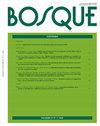Modelos de cambio en cobertura forestal de la cuenca del río Manso inferior ¿Una herramienta para definir estrategias de manejo?
IF 0.6
4区 农林科学
引用次数: 0
Abstract
Many Andean forests of Northwestern Patagonia have expanded over burned areas during the last century. In this article, we combine maps from early 1900s with potential distribution models based on recent forest cover maps of the region to estimate the long-term responses of the three main forest communities of seed-obligate forests, Nothofagus pumilio, N. dombeyi and Austrocedrus chilensis, to land-use changes within the Manso river basin. This valley has the highest potential for forest management in the Rio Negro Province. Our results indicate that the forest area of the Manso river basin has doubled over the last 100 years. The lenga forests expanded over xeric shrublands in the valley, coihue forests advanced primarily over burned areas at the beginning of the 20th century, while cypress forests advanced both in shrublands and burned areas. Land cover change analysis indicates that A. chilensis forests are the community with the highest relative increment. We conclude that, under current scenarios of climate change, shrubland management combined with a strategy of conversion to productive N. dombeyi and A. chilensis forests in key areas would improve current policy, which is characterized by a lack of forest management in areas under the National Park System as well as under provincial administration.下曼索河流域森林覆盖率变化模型是否是确定管理战略的工具?
巴塔哥尼亚西北部的许多安第斯森林在上个世纪已经被烧毁。在这篇文章中,我们将20世纪初的地图与基于该地区最近森林覆盖地图的潜在分布模型相结合,以估计三个主要的种子专性森林群落,即Nothofagus pumilio、N.dombeyi和Austrocedrus chilensis,对曼索河流域土地利用变化的长期响应。这个山谷是里约内格罗河省森林管理潜力最大的地区。我们的研究结果表明,曼索河流域的森林面积在过去100年中翻了一番。lenga森林在山谷中的xeric灌木林上扩张,coihue森林在20世纪初主要在燃烧区发展,而柏树林在灌木林和燃烧区都发展。土地覆盖变化分析表明,智利林是相对增量最大的群落。我们得出的结论是,在当前的气候变化情景下,灌木林管理与在关键地区转变为生产性董贝和智利a.chilensis森林的战略相结合,将改善当前的政策,其特点是国家公园系统和省级行政区域缺乏森林管理。
本文章由计算机程序翻译,如有差异,请以英文原文为准。
求助全文
约1分钟内获得全文
求助全文
来源期刊

BOSQUE
Agricultural and Biological Sciences-Forestry
CiteScore
0.70
自引率
0.00%
发文量
0
期刊介绍:
BOSQUE publishes original works in the field of management and production of forestry resources, wood science and technology, silviculture, forestry ecology, natural resources conservation, and rural development associated with forest ecosystems. Contributions may be articles, rewiews, notes or opinions, Either in Spanish or English.
 求助内容:
求助内容: 应助结果提醒方式:
应助结果提醒方式:


